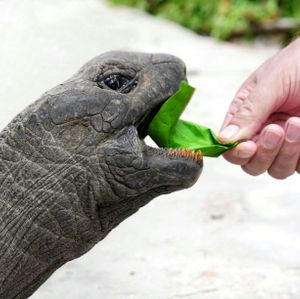
Tortoises are herbivores, meaning that their diet consists largely of plants. However, feeding your tortoise an appropriate diet goes beyond just giving them a tossed salad each day. Feeding a balanced diet is essential to keeping your tortoise happy and healthy. Variety is key. When deciding the right diet for your tortoise two important factors have to be taken into account: age and species.
Neonatal and juvenile tortoises are actively growing and will require daily feeding. Careful attention needs to be paid to providing the correct levels of calcium in their diet to help build healthy bones. Mature adult tortoises only need to be fed 3 to 4 times a week.
A tortoise’s dietary needs reflect its natural habitat. Because of this, tortoises that originate from deserts or grasslands do better on high-fiber diets consisting of chopped hays and grasses. However, tortoises from more tropical or forest habitats tolerate higher amounts of fruits.
Grassland/Desert Species:
Sulcata/Spurred tortoise, Leopard tortoise, Aldabra tortoise, Star tortoise, Radiated tortoise, Gopher tortoise, Desert tortoise, Greek tortoise, Hermann’s tortoise, Russian tortoise, Mediterranean tortoise
Tropical/Forest Species:
Hingeback tortoises, Red-footed, Yellow-footed, Elongated tortoises
Grasses (esp. timothy and Bermuda), weeds (fresh cut or browsed; dandelions, clover, legumes, plantains), store-bought greens (mustard, collards, radish and turnip greens, kale, cabbage, bok-choy, broccoli rape), flowers (mulberry, hibiscus, carnation squash), cured moistened hays (alfalfa or timothy); soaked alfalfa pellets, and lesser amounts of spinach, Swiss chard, beet greens, red leaf or romaine lettuce, and frozen mixed vegetables. Iceberg lettuce has little nutritional value and should be avoided completely!
grapes, apples, oranges, pears, prickly pears, peaches, plums, nectarines, dates, melons, tomatoes, etc.
Proper supplementation is also very important in maintaining your tortoise’s health. Food should be dusted with a quality powdered calcium supplement with every feeding and a multivitamin powder once every 2-4 weeks. In order to utilize calcium tortoises need to have exposure to ultraviolet or UV light, specifically a type of UV light called UVB. Tortoises housed outdoors will receive this directly from the sun. However, this light cannot penetrate glass so indoor tortoises need to have the light supplied by specialized UVB bulbs manufactured for reptiles. It is important to follow the manufacturer’s instructions when using these bulbs as the UVB will be used up before the bulb stops producing light. Most will require changing every 6 months.
Inappropriate diets are the number one primary cause of disease in tortoises. Inadequate nutrition can result in irreversible damage to a tortoise’s health. While the best thing is to avoid these problems with proper nutrition, it is important to recognize these diseases early before it is too late. Nutritional diseases can be split into two main categories: diseases of dietary deficiency and diseases of dietary excess.
Metabolic bone disease can result from poor nutrition or poor husbandry or both. Causes include deficiencies in calcium or vitamin D, imbalance in the calcium-phosphorus ratio, or lack of adequate UVB light exposure. Clinical manifestations depend on the age of the tortoise. In adults we see decreased bone density and the bones may become brittle resulting in fractures. In juvenile tortoises, we see the abnormal shell development known as pyramiding and beak over-development. We may also see bowing of the limbs as the bones fail to calcify as the animal grows. Prevention of this condition depends on good nutrition, adequate calcium supplementation, and providing UVB lighting to support calcium metabolism. While changes to the shell are irreversible, a reptile veterinarian should be sought for advice and treatment to increase bone density and to prevent further deformities. Dietary and environmental problems should also be addressed and corrected.
Vitamin A deficiency is seen with diets low in β-carotene, such as large amounts of iceberg lettuce or cucumbers. Vitamin A is important for healthy skin, respiratory tract, and eyes. Clinically, deficiencies may be manifested as upper respiratory tract disease, beak deformities, ear abscesses and infections, conjunctivitis, lower respiratory tract disease, skin abnormalities, and vision problems. In tortoises, vitamin A deficiency can be easily avoided by feeding a varied diet which includes dark, leafy vegetables.
Feeding larger than recommended amounts of protein-based foods, such as dog and cat foods, meats, and commercial tortoise pellets can result in rapid, uncontrolled growth which may cause beak deformities and pyramiding. Diets high in protein can also lead to a condition known as gout. When protein is broken down in the body it produces waste products that are eliminated by the kidneys in urine. In animals, like tortoises, who aren’t built to handle a large amount of proteins the kidneys become easily overwhelmed and may even become damaged. These protein wastes build up and deposit in the joints and/or internal organs. This condition can be very painful and often fatal. Clinically this condition is seen as swelling of the joints, depression, and dehydration. It is important to feed only very small amounts of these protein-based foods or avoid them completely. Treatment should be sought immediately with a reptile veterinarian.
Clinical manifestations of Hypervitaminosis D are very similar to that of gout. This condition results from feeding monkey, dog, or cat foods that contain high levels of vitamin D. Abnormally high levels of vitamin result in calcium becoming deposited in joints and organs. This condition is easily prevented by avoiding these foods.
Copyright © All Rights Reserved
